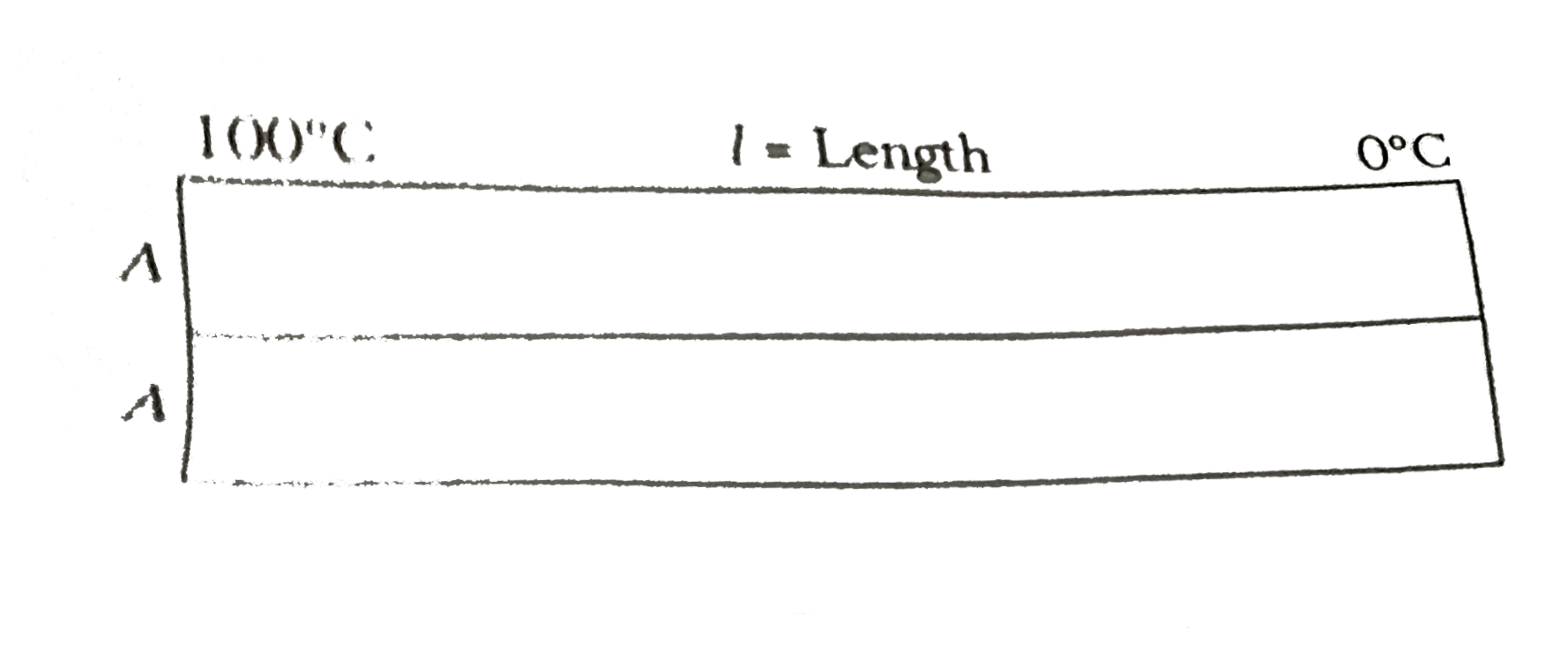Two identical rods are connected between two containers. One of them is at 100∘C containing water and another is at 0∘C containing ice. If rods are connected in parallel then the rate of melting of ice is q1g/s . If they are connected in series then teh rate is q2g/s . The ratio q2/q1 is
2
4
12
14
The correct Answer is:D
According to the question,
When two identical rods are connected in parallel,

So, rate of heat transfer is given by
dQdt=2KA(T1−T2)=2KA(100−0)l=200KAl
where, net area = 2A
K = thermal conductivity constant
T1 = temperature at one end
T2=temperature at other end
l = length of rod.
As, dQdt is rate of heat transfer = (mL)/(T)<br>So,g_(1)=(dQ)/(dt) = Q/T rArr (m/T)L = (200KA)/l<br>So,forparal≤lco∩ection,<br>(m/T)=g1s=200KALl............(ii)<br>Similarly,forseriesco∩ection<br><imga≤ocr_imageload∈g=lazysrc=https://d10lpgp6xz60nq.cloudfront.net/physics_images/ARH_NEET_PHY_OBJ_V01_C16_E01_191_S02.pngwh=80%mx-autosty≤=background:white;margin-top:12px;margin-bottom:12px;><br>So,(100 - T_(0)=T_(0)-0 rArr 2T_(0)=100<br>rArr T_(0)=50
So, dQdt=(ml)L=KA(50−0)l
and it can be written as,
g2(g/s)=KA50lL.............(ii)
Dividing Eqs. (i_) and (ii), we get
g1g2=20050=4⇒g2g1=14
Similar Questions
दो समरूप चालक छड़ें प्रारम्भ में दो बर्त्तनों से अलग-अलग जुड़ी हैं, एक बर्तन में 100∘C पर पानी एवं दूसरे बर्तन में 0∘C पर बर्फ रखा है। बाद में द्नों छड़ों के सिरों को आपस में जोड़कर दिये गये दो बर्तन से जोड़ा जाता है। यदि इन दोनों स्थितियों में बर्फ के पिघलने की दर क्रमश: q1 एवं q2 gm/s हो तो q1/q2 का मान है
View SolutionTwo conductors, one having resistance R and another 3R are connected in turn across a d.c. source. If the rate of heat produced in the two conductors is Q1 and Q2 respectively, then find their ratio.
View Solutionदो समरूप चालक छड़ें प्रारम्भ में दो बर्तनों से अलग-अलग जुड़ी हैं, एक बर्तन में 100∘C पर पानी एवं दूसरे बर्तन में0∘C पर बर्फ रखा है। बाद में दोनों छड़ों के सिरों को आपस में जोड़कर दिये गये दो बर्तन से जोड़ा जाता है। यदि इन दोनों स्थितियों में बर्फ के पिघलने की दर क्रमशः q_(1) " एवं " q_(2) ग्राम/से हो तो q1/q2का मान है
View SolutionTwo identical conducting rods are first connected independently to two vessels, one containing water at 100∘C and the other containing ice at 0∘C. In the second case, the rods are joined end to end and connected to the same vessels. Let q1andq2 gram per second be the rate of melting of ice in the two cases respectively. The ratio q1q2 is
(a) 12 (b)21 (c)41 (d)14
View SolutionTwo identical conducting rods are first connected independently to two vessels, one containing water at 100^@C and the other containing ice at 0^@C . In the second case, the rods are joined end to end and connected to the same vessels. Let q_1 and q_2 gram per second be the rate of melting of ice in the two cases respectively. The ratio q_1/q_2 is (a) 1/2 (b) 2/1 (c) 4/1 (d) 1/4
View SolutionTwo identical rods are connected between two containers. One of them is at 100∘C containing water and another is at 0∘C containing ice. If rods are connected in parallel then the rate of melting of ice is q1g/s . If they are connected in series then teh rate is q2g/s . The ratio q2/q1 is
View Solutionदो समरूप चालक छड़े, पहले स्वतंत्र रूप से लेकिन एक साथ दो पात्रों के बीच, जिसमें से एक में 100∘ C पर जल है और दूसरे में 0∘C पर बर्फ है, जुड़ी हुई हैं। दूसरी स्थिति में, छड़ें श्रेणी क्रम में जुड़ी हुई हैं और तब संयोजन समान पात्रों के बीच जुड़ा हुआ है। माना q1 और q2 क्रमश: दो स्थितियों में बर्फ के पिघलने की दर (gs−1 में) है। अनुपात q1q2 हैं |
View SolutionTwo identical conducting rods are first connected independently to two vessels, one containing water at 100^(@)C and the other containing ice at 0^(@)C . In the second case, the rods are joined end to end connected to the same vessels. Let m_(1) and m_(2) g/s be the rate of melting of ice in the two cases respectively, the ratio (m_(1))/(m_(2)) is
View Solution

